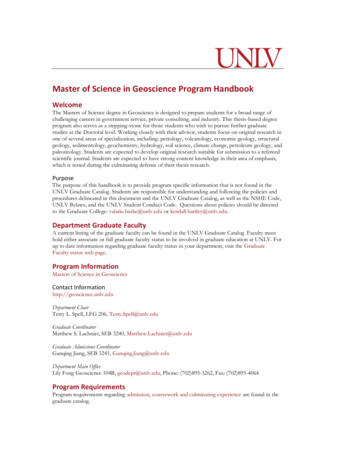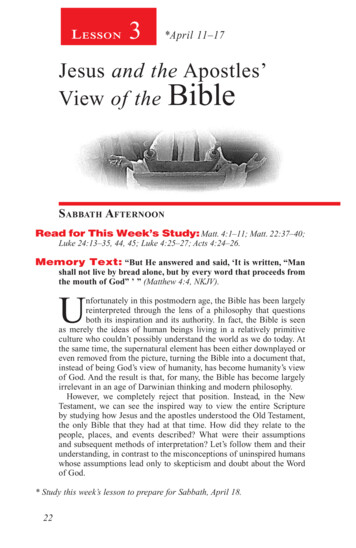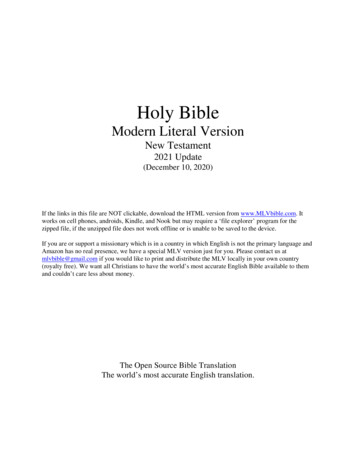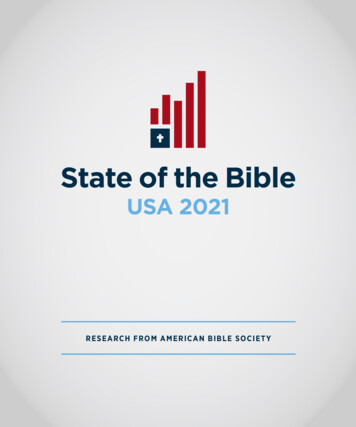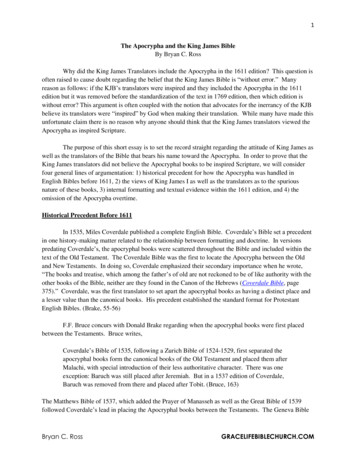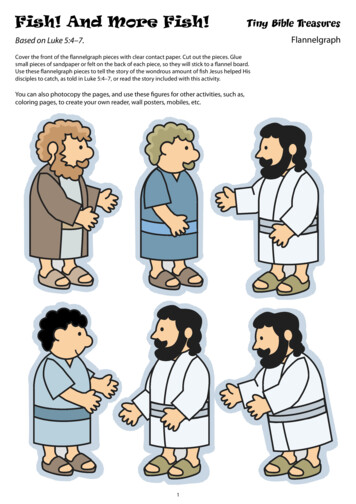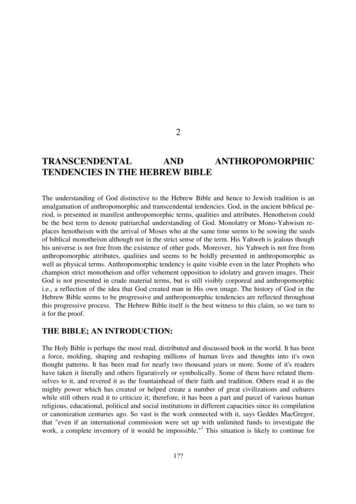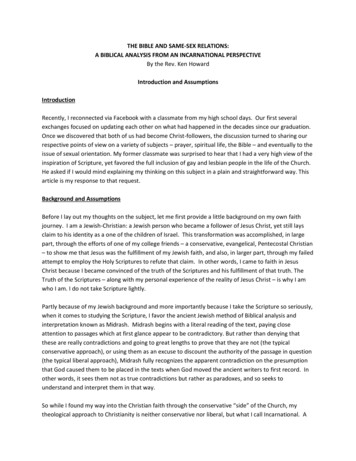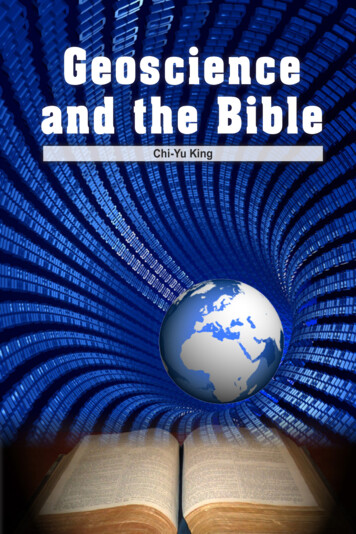
Transcription
Geoscienceand the BibleChi-Yu King
Geoscience and the BiblePublisher:Great Commission Center InternationalAuthor: Dr. Chi-Yu KingUSA848 Stewart Drive, Suite 200, Sunnyvale, CA 94085, USATel: 1-408-636-0030E-mail: info@gcciusa.orgWeb site: http//www.gcciusa.orgHong KongRoom 201, General Commercial Bldg. 156-164 Des Voeux Road,Central, Hong KongTel: (852) 2540-0131E-mail: gcci852@gmail.comCanadaToronto:9670 Bayview Ave, Richmond Hill, ON L4C 9X9, CanadaTel:(905)884-3399, Fax: (905)884-9465E-mail:admin@gccica.orgJune 2016 1st printcopyright@2016ISBN
ContentPrefaceiForewordiiChapter 1Science and Christian Faith6Chapter 2God Created, Made, Formed,and Established the Worlds11Chapter 3Volcanic Eruptions25Chapter 4Earthquakes witness to the Bible31Chapter 5Science and the Bible38Chapter 6Geophysical phenomena atJesus’ second comingChapter 741Geophysical Phenomena atJesus’ death and resurrection47Chapter 8To Fathom “the Infinite” with “the Finite”51Chapter 9“God Particle”54Chapter 10Solar Wind and Geomagnetic Field57Chapter 11 The Function and Mission of God’s People60Chapter 12 A geophysicist’s life led by the Good Shepherd67
PrefaceGeoscience and the Bible is a broad and profound subject, whichordinary people as well as intellectuals dare not write about lightly. Butthanks to God’s leading, Dr. King made such an effort on the basis of hislong-term research career and his Christian faith, both spanning over ahalf century. Hopefully, through this book, many readers may understandthat not only is there no real contradiction between science and the Biblebut also that many Bible statements predate scientific discoveries, sometimes by hundreds or even thousands of years.God created the vast cosmos, including the galaxies, the earth, andall things. In contrast to this great mystery and power of His, the socalled “scientific discoveries” achieved by men are but mere shells andseaweeds picked up by children playing on the beach, for which theyare proudly celebrating in joy or even boasting, “Man shall overcomeNature.” What a pity!Dr. King, after receiving a Ph.D. in Applied Physics from Cornell University, was engaged in scientific research in geophysics, with an emphasison earthquakes, first at the California Institute of Technology, then at theUniversity of California in Los Angeles, the U. S. Geological Survey, theNational Oceanic and Atmospheric Administration, and the University ofTokyo. He and his wife are both devoted Christians, serving God, churches,and missionary organizations, such as GCCI, for many years.This is a book not only on Science and the Bible but also on Apologetics. We believe it will be a bright lamp for the faith and truth, helping many people in this generation to “remove the cloud that shields thesun” and will serve as a wake-up call. We hope that it may help them toovercome many rational obstacles, so they may accept Christ and obtaineternal life.May God use this book greatly, gathering a vast harvest for Himselfin these end times. Amen!Thomas WangMarch 2016i
ForewordThe scope of geoscientific studies includes the earth, its ocean, andatmosphere. This is also the field in which God entrusted mankind tomanage, when He created them. The Bible has many descriptions in thisregard, which can be compared with later geoscientific discoveries.I have been a research geoscientist and a Christian, both for overa half century, and have published a series of short articles reporting theresults of such comparison. The studies consistently show that the Biblical statements are not only not contradictory to the scientific discoveriesbut also pre-date them, sometimes by many centuries. These articles, andsome unpublished ones, are collected here in this book, together with apersonal testimony. May God use this book to help readers to overcomecertain rational difficulties that they may have, so that they may recognizethat the Bible is the inspired word of God, telling truths and facts. And,thus, they may believe Jesus, to whom the Bible testifies, to be the Son ofGod, who died on the cross to save mankind from sin and death.The articles included here are arranged in chronological order ofpublication. All quoted Scriptures are from New King James Version ofthe Bible, unless noted otherwise. I am grateful to GCCI for publishingthe book, to Annie Li for careful editing, and to Rev. Thomas Wang forwriting the preface.ii
Geoscience and the BibleChapter 1Science and Christian Faith:Are they Mutually Exclusive orContradictory?The Biblical idea of human origin by God’s creation is totally excludedtoday from the scientific curriculum in public schools across America on theground of separation of science and religion. Science and religion are considered to be two different areas of human endeavor without overlap. Religionis supposed to be undertaken by faith, whereas science pursued by carefulobservation and reasoning. Such a clear-cut division between science andreligion is, however, artificial and not appropriate, at least for Christianity.Here, and in some later articles, I’ll try to explain why science and Biblebased Christianity are not mutually exclusive, nor contradictory, and why thepossibility of creation should be permitted in an objective study of humanorigin, along with the theory of evolution.Science and Bible-based Christianfaith are not mutually exclusiveAlthough the main message of the Bible is God’s salvation of mankindfrom sin and death, its content touches all aspects of life, including thingsrelated to science. Many parts of the Scriptures that overlap with science arewritten with sufficient detail and can be rationally examined.6
Geoscience and the BibleIt is true that the Bible also contains cases of super-natural phenomena,or miracles, which seem to defy scientific explanation. Such difficulty, however, dissolves if one accepts the basic presumptions of the Bible, namely,the existence of a supernatural God who has not only created the universebut also ordained various laws to govern the natural processes. He himself,however, remains above the laws and can occasionally intervene with lawbreaking doings, namely, “miracles.” The Biblical account of creation, unlike many ancient legends stated elsewhere, is self-consistent and reasonable, and is detailed enough to be examined rationally. Unfortunately manycritics have not bothered to study carefully what the Bible has to say.Not only the Bible has certain “self-evident” presumptions, such asGod’s existence; so does science. Two fundamental presumptions underlying most scientific studies are atheism and materialism. While God’s existence is not proven scientifically, so is His non-existence. Many things existbut cannot be proven due to limitation of human capability. Electromagneticwaves, for example, had existed in the sky long before they were detected bymankind when radio receivers were invented. Our scientific knowledge hasadvanced greatly since then but is still limited. Thus, science cannot proveGod’s non-existence, and atheism is a dogma, or even a religious belief, thathas to be taken by faith also.Materialism, which assumes the universe to consist of only materials(and energy) but nothing else (such as spirit), is not scientifically proveneither. Based on these atheistic and materialistic presumptions, the evolutiontheory has ignored the unique spiritual dimension of human beings that setthem apart from the animals and derived the conclusion of human’s evolution from lower animal species. This situation is somewhat like consideringonly the similarity in the hardware of different computers, but ignoring thedifference in their software. Examining only partial evidence, no matter howrigorous, often leads to erroneous conclusions.Common ingredients: truth and factsThe purpose of science is to search for truths on the basis of observedfacts. Truths and facts are also the basic concern of the Bible. For example,Apostle John declared, “That which was from the beginning, which we haveheard, which we have seen with our eyes, which we have looked at andour hands have touched – this we proclaim concerning the word of life (Je7
Geoscience and the Biblesus) ” (First John 1:1-2). So did Luke at the beginning of his gospel, whichincludes many miracles like Jesus’ birth and resurrection, “Many have undertaken to draw up an account of the things that have been fulfilled among us,just as they were handed down to us by those who from the first were eyewitnesses and servants of the word. Therefore since I myself have carefully investigated everything from the beginning, it seemed also goodto me to write an orderly account for you, so that you may know thecertainty of the things you have been taught.” (Luke 1:1-4; NIV edition).Jesus declared, “I am the way and the truth and the life ”, and “Your(God’s) word is truth ”(John 14:6; 17:17).Difference in presumptions, scope, and approachesWhile having the same concern about truth and facts, the Bible is different from science in its approaches to truths, beside the above-mentioneddifference in presumptions and scopes (i.e., the inclusion of spiritual dimension in the Bible).Scientific theories are derived solely by human observation and reasoning. Because of the limitations of human’s capabilities in observation andreasoning, scientific knowledge is limited and continually evolving. Thusscientific theories are always tentative, subject to modification and refinement. For example, the previously accepted law of Conservation of Mass andthe law Conservation of Energy (or First law of thermodynamics) were laterfound to be not exact and were superseded by Einstein’s Special-Relativitytheory (of convertibility between mass and energy).The Biblical approach is, on the other hand, not only made by humanbut also by the inspiration of God. Since God created everything and is stillsustaining the universe (Hebrews 1:2-3), He knows everything and shouldnot make any mistake in the Bible He has inspired. This is why the Bible remains intact in the midst of numerous critical attacks over the past thousandsof years, while scientific textbooks have to be revised every few years.This difference in the approaches may be illustrated by considering thecase of learning how to use some modern electronic equipment, such as acomputer. We may either learn by experience or by studying the manual provided by the manufacturer (or both). The knowledge obtained by a user’sexperience (equivalent to the scientific approach) is rather limited and will8
Geoscience and the Bibleeventually agree with what is written in manufacturer’s manual (equivalentto the Bible).Historically, there have been cases in which the Scriptures seemed to becontradictory to scientific conclusions. These apparent contradictions havelater been found to be either due to misinterpretation of the Scriptures (e.g.,the pope’s insistence on a geocentric universe at the time of Galileo) or due toa lag in scientific discoveries (e.g., cause of earthquakes, as will be discussedin Chapter 4), sometimes by thousands of years.As a Christian and scientist, both for more than 50 years, I have foundno problem in reconciling my research with the Christian faith that recognizes the power of the almighty God. My comparative study between scienceand the Bible has not shown any real contradiction, and I have been repeatedly amazed by the correctness and far-sightedness of the Bible.ConclusionsThere is no real contradiction between science and science-related matters described in the Bible. If the study of evolution theory, which is basedon the scientifically unproven presumptions of atheism and materialism,is allowed in science classes at schools, why is not the possibility of creation allowed, or even mentioned? Is this practice not contrary to the spiritof unbiased open-minded free inquiry that characterizes scientific studies?Worthwhile ideas, regardless of their origin, should never be excluded fromscientific pursuit of truths!Quoted ScripturesHebrews 1: 2-3: “God.has in these last days spoken to us by His Son,whom He has appointed heir of all things, through whom also He madethe worlds; who being the brightness of His glory and the express image of His person, and upholding all things by the word of His power.”9
Geoscience and the BibleChapter 2God Created, Made,Formed, and Establishedthe WorldsWhat is the origin of mankind? Is it through God’s creation as presented in the Bible, or by evolution from some animal as proposed by Darwin(1859) and others? This question has been hotly debated for over a century,but many people involved in the debate have been inadequately educatedeither in science or in the Bible. (Many relevant articles can be found on theInternet using Google by searching “Evolution vs. Creation”.) Having beena Christian as well as a scientist for over 50 years, I would like to present inthis article my personal view of this controversy.1. Some Preliminary RemarksSimilarities and Differences between Science and Christian FaithScience and religion are usually considered to be two entirely differentrealms of human endeavor; religion is to be accepted by faith, whereas science pursued by observation and logical reasoning. But for Christianity, thisdichotomy is inappropriate, because the Christian Bible not only presents themessage of God’s love and salvation of mankind from sin and death, but alsotouches various aspects of human life, including scientific matters, and thedescriptions are often detailed enough to be examined rationally.10
Geoscience and the BibleOf course, the Bible includes certain miracles and wonders that contradict known natural laws, thus are seemingly scientifically impossible. But ifone is willing to accept the presupposition of the existence of a supernaturalGod, as described in the Bible, then this difficulty becomes dissolved. ForGod is not only the creator of the universe, but also the One who establishedall the laws that scientists have discovered to be regulating the various movements in the universe. He himself is, of course, beyond all of these laws and,when deemed appropriate, can break some to perform the so-called miracles.Not only the Bible has some “self-evident” presuppositions—sciencedoes also. Two of the major intrinsic presuppositions of most scientific studies are atheism (no God) and materialism (nothing else exists, except massand energy). Although the existence of God cannot be proven scientifically,so does His non-existence. There are many things in the universe that do existbut cannot be scientifically proven, due to the limitations of human’s ability.Despite the immense achievement of science today, it is still limited. Thus,atheism is also a presumption, which has to be taken by faith. So is materialism. Many scientists today do not accept God’s existence, and thus cannotaccept the miracles and creation stated in the Bible.However, the fundamental nature of the Bible is facts and truth, whichis no different from science. Though, there is a difference in the way howknowledge is obtained. Scientific knowledge is obtained entirely through human observation and logical reasoning. Since man’s ability in both is limited,as mentioned above, scientific conclusions are always tentative, subjectingto refinement and modification, pending new findings. They are thus not ultimate truths. On the other hand, the Bible claims to be inspired by God, who,being the creator of all things, knows all things. Thus, the Biblical truths Heinspired cannot be wrong and should be ultimate truths. Historically, scientific conclusions have often been modified, while the Bible has stayed thesame over thousands of years. Despite numerous attacks, it has remainedintact. Although there have been some cases in which scientific findings apparently contradict Biblical statements, they were later found to be due toeither misinterpretation of the Bible or a lag in scientific findings behind theBiblical statements, as will be illustrated later.The creation process mentioned in Genesis and many other books inthe Bible was written a long time ago, over a period of about 1,500 years(approximately from 1400 BC to 100 AD) by various authors of differentbackgrounds. These different accounts are nonetheless very coherent and11
Geoscience and the Bibleself-consistent and, when put together, are detailed enough to be examinedrationally (unlike many other ancient legends about the origin of the universe).Evolution and Big-Bang TheoriesDarwin’s evolution theory was proposed to explain many observations,but it cannot explain many others. Examples of the latter kind include someobviously huge differences between humans and animals. For example, whydo only human beings wear clothes even when it is very hot, while no otheranimals do, even when it is very cold? Why can a sick person receive a bloodtransfusion from another person having the same blood type, even of different race, but not from any animals? Why cannot mankind (or animals)interbreed normally with other evolutionarily-related animals? Why do onlyhumans worship God or have religious activities, while no other animals door can do? Other well-known differences include man’s great superiority inlanguage, art, civilization, science, and technology. Throughout the knownhistory of several thousand years, humans have made tremendous progress inthese various areas, while animals seem to have remained the same withoutany obvious changes.Also, the evolution theory does not answer adequately the question of“the first cause” (the ultimate origin of everything). As a matter of fact, noscientific or philosophical theory does. The evolution theory suggests thathuman ancestors evolved from some lower animals progressively over along period (a hypothesis still not supported convincingly by fossil evidenceas Darwin had hoped). It does not explain adequately where the first livinganimal or cell originated. The arguments that it was evolved from certainorganic materials, which in turn was evolved from certain inorganic materials, all suffer the lack of definitive scientific evidence. Even if one acceptssuch arguments by faith, one still may wonder: “Where did all the inorganicmaterials come from?”To answer this question of “the ultimate origin of everything,” oneneeds to seek help from the Big-Bang theory, currently accepted in astronomy. According to this theory, the universe was not eternally in existence, buthad its beginning in a “big bang,” or explosion, at a certain “singular” pointsome billions of years ago. This theory, however, does not address adequately such questions as: What was there before the big bang? Why was theresuch a big bang? Why is the universe so orderly after the big bang (unlike12
Geoscience and the Biblethe messy aftermath of a big explosion ordinarily seen)? Who ordained, andis still enforcing, the various natural laws in the universe after the big bang?As mentioned above, as a scientific theory, evolution is based on the unproven presuppositions of atheism and materialism. By assuming that thereis no God and no creator, one is forced into accepting the concept of evolution of one species from another. For example, if one assumes (ridiculously)that there is no manufacturer of robots, then to explain the origin of all kindsof robots, one is forced to accept the assertion that newer and more sophisticated robots evolve automatically from some older, simpler ones, withouthuman intervention. Likewise, by assuming that there are only materials (andenergy), the theory compares only the physical parts between human andanimals, not their spiritual and soulish parts, as the Bible does. The situation is somewhat like considering only the hardware of a computer withoutconsidering the software that controls the hardware. As we all know, if oneconsiders only some partial evidence, he is very likely to reach a wrong conclusion, no matter how rigorously logic his reasoning may be.Age Calculation By Biblical GenealogyMany people, including some Christians, think that the Bible showsthat the human ancestors and the whole universe were created by God aboutsix thousand years ago. Actually, this is not stated in the Bible, but was estimated in 1664 by Bishop Ussher of Ireland, among others, based on thegenealogies given in the Bible. Bishop Ussher, however, did not realize thatthe words “begot” and “son” in the original languages of the Bible, Hebrewand Greek, might be used for not only the father-son relationship, but alsoancestor-descendent relationships in general. For example, Jesus is called theson of David and son of Abraham (Mt. 1:1), even though they were separatedby many generations. Thus Ussher’s estimation of six-thousand years maybe significantly shorter than the actual length of human history stated in theBible. In other words, the Bible does not preclude the possibility that the creation process described in Chapter 1 of Genesis took place at a significantlyearlier time.God Created, Made, Formed, and Established the WorldsEven with the above consideration, one still can not reasonably extendthe period of six thousand year to millions and billions of years, as suggestedby geological and astronomical evidences. There is, however, another important point mentioned in the Bible that has been commonly ignored: God cre-13
Geoscience and the Bibleated and made not just one world, but more than one. For example, Hebrews1:2 says, “ through whom (the Son) also He made the worlds”. The word“worlds” in the original Greek language implies the worlds that are differentin time (at different time on the same earth), not in space (on different planetsat the same time). This point is clearly stated in Second Peter 3:5-7: “ theworld that then existed perished, being flooded with water. But the heavensand the earth which are now preserved by the same word ” The Bible doesnot provide detailed information about the previous world(s), perhaps because such information is not directly relevant to the main purpose of the Bible, which is the salvation of mankind in the present world. The possibility ofthe destruction of previous world(s) may, however, explain the extinction(s)of many species millions of years ago, as evidenced by fossil records.The Bible also mentions how God created the material worlds out of“nothing” (or something invisible, non-material), namely, by speaking Hisword: “By faith we understand that the worlds were framed by the wordof God so that the things which are seen are not made of things which arevisible.”( Heb.11:3; see also Ps. 33:9; Jn 1:1-3). How God can “create” thematerial things out of “nothing” by merely speaking remained mysteriousfor thousands of years, until Einstein’s discovery of mass-energy convertibility in his Special Relativity Theory published about one hundred yearsago. Since, according to the Bible, God’s word is powerful (thus full of energy, unlike man’s word) and is living and intelligent (Heb.4:12; Jer. 10:12;Proverbs 3:19), it is understandable that He could have created the orderlyphysical worlds full of living beings by merely speaking.Another point often ignored by many people is that the Bible uses several different verbs in describing God’s working, including: “Create” (material) things out of “nothing (material)”, as well as “make,” “form,” and “establish” things out of existing things. For example, Isaiah 43:7 uses three ofthese verbs in the case of man: “Everyone who is called by my name, whomI have created by my glory; I have formed him, yes, I have made him.” Isaiah45:18 even uses all four of them: “For thus says the Lord who created theheavens, who is God, who formed the earth and made it, who has establishedit ” Other scripture verses, however, often use only one or two of theseverbs for simplicity, even though God’s action may have involved more. Insuch cases, they should not be construed as being excluding the possibility ofGod’s other “doing” components. Man can make, form, and establish thingsbut cannot “create” things out of “nothing” in the Biblical sense.14
Geoscience and the BiblePoints of View in the BibleAlthough all Scripture is given by inspiration of God (2 Tim. 3:16),the readers of its messages are humans, both ancient and modern. Thus, instudying science-related Bible verses, we need to keep in mind that they aresometimes written from the viewpoint of mankind on earth before the advancement of modern science, but at other times from the viewpoint of God.2. God’s Action Described in Genesis 1 and 2The Beginning (v. 1)Having clarified the above-mentioned several points, we may now tryto better understand the creation process described in Chapter 1 of Genesis(which was written about 3,400 years ago!). In verse 1:1, “In the beginningGod created the heavens and the earth,” the verb “created” (out of “nothing”)is used. Thus it may be a statement about the very beginning of the universe,which is not inconsistent with the “Big Bang” theory of astronomy in that theuniverse has a beginning. The Bible does not preclude the possibility that thebig bang occurred many billion years ago, since no time frame is mentionedhere. Stated elsewhere also is the expansion (stretching out) of the universe(Isaiah 42:5 and 45:12), which is observed astronomically too. In addition,the Bible can explain such an occurrence better than the Big-Bang theory,because it states who did this (God) and how, by speaking (see also John 1:1and 3: “In the beginning was the Word, and the Word was with God, and theWord was God. [ ] All things were made through Him, and without Himnothing was made that was made.”). Thus, this great, orderly, and expandinguniverse did not come into existence by itself by chance, but by God’s designand creation, manifesting God’s great power and intelligence. Note also thatthe words of plural “heavens” and singular “earth” used here are both soappropriate, because in contrast to the unique earth, the heavens include notonly the firmament (the earth’s atmosphere; see verse 8) but also the moon,the sun, and numerous stars in the galaxies, which are much farther away.This usage, again, antedates the corresponding scientific discovery.End of the Previous World (v. 2a)The statement “The earth was without form, and void; and darknesswas on the face of the deep” in verse 2a is not likely to be a description of theoriginal condition of the freshly created earth (Isaiah 45:18; 1 Timothy 4:4),because things created by God are supposedly good. It could be the condi-15
Geoscience and the Bibletion of the earth at the end of the previous world, perhaps billions of yearsafter the initial creation (1:1) and just prior to God’s creating/making/shaping/establishing the present world. At that time, water (including vapor, fog,and cloud) covered not only the surface of the earth, but also the atmosphereup to a great height, such that the (pre-existing) sunlight could not penetratethrough the atmosphere and reach the surface (even on top of the highestmountains at that time). Thus the surface was in darkness. This interpretationof the Bible is consistent with verses 6-8, as shown below.Why had the earth “deteriorated” so much at that time? One possibilityis that the previous world was destroyed by God (Jer. 4:23) because of thefall of Satan, who had been put in charge of that world, as hinted in Isaiah14:12-17 and Ezekiel 28: 12-19, where the kings of Babylon and Tyre arecommonly considered to represent Satan. The Bible does not explicitly mention when the angels were created, except that it must have been before thecreation of the present world (Job 38:4-7). Other Scriptures also mentionedthe ruling ability of the angels (Lk 4:6; Heb 2:5).A similar judgment/destruction occurred at the time of Noah, and another is predicted to be occurring in the future (Jer. 4:23). The destructionmentioned in verse 2 may have destroyed many, if not all, creatures of thatworld, such as trees and animals, and thus caused their extinction, leavingtheir remains as fossils. Since no time frame is mentioned in Genesis 1:2, theBible does not preclude the possibility that such fossils were many millionyears old, as determined by scientific dating techniques.16
Geoscience and the BibleHow did God execute the above-mentioned destruction? One possibility is by using the well-known but rarely occurring natural phenomena ofmassive meteoroid/asteroid impacts. More and more scientists are now convinced that such impacts on earth were responsible for repeated extinctionsof plant and animal on earth, including dinosaurs some 65 million years ago.The scenario described in Genesis 1:2 could be the result of some such impacts, primarily on water, that would have splashed huge amounts of waterand other debris into the atmosphere, blocking sunlight from reaching theearth’s surface and shutting down photosynthesis for a long period, thus destroying the environmental condition suitable for living. Some impacts mayhave triggered gigantic earthquakes, tsunamis, and/or volcanic eruptions,with even more serious consequences.Preparatory Work of the Holy Spirit (v. 2b)The creating, making, and shaping of the present world by the triuneGod during a six-day period (Exodus 20:11) is then described in more detailin the following verses. In preparation, “the Spirit of God was hovering overthe face of the waters.” (v. 1:2b). Note that the word “waters” is plural. Thusthis sentence may possibly define the scope of God’s work on this world atthat time, namely, the earth and its atmosphere, where massive amount ofwaters existed.Appearance of Light on the First Day of the Present World (v. 3-5)On the first day of this world, God let light become visible on the earth’ssurface (Again, verse 3 describes the condition from the point of view of thesoon to be created humans). Note that the Bible does not use the word “create” here. Thus, the light was not coming from a new source, but from thesame sun
thus, they may believe Jesus, to whom the Bible testifies, to be the Son of God, who died on the cross to save mankind from sin and death. The articles included here are arranged in chronological order of publication. All quoted Scriptures are from New King James Version of the Bible, unl
